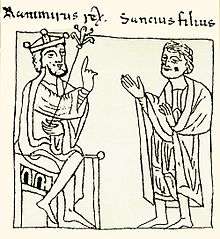Sancho Ramírez
| Sancho Ramírez | |
|---|---|
 Sancho (Sancius filius, Sancho the son) with his father, King Ramiro (Ranimirus rex) From a thirteenth-century manuscript of Jaca | |
| Spouse(s) |
Isabella of Urgell Felicia of Roucy |
|
Issue | |
| Noble family | House of Jiménez |
| Father | Ramiro I of Aragon |
| Mother | Ermesinda of Bigorre |
| Born | c. 1042 |
| Died |
4 June 1094 (aged 51–52) Huesca |
.jpg)
Sancho Ramírez (c. 1042 – 4 June 1094) was King of Aragon (1063–1094, not formally until 1076) and King of Navarre (from 1076, as Sancho V). He was the son of Ramiro I of Aragon and Ermesinda of Bigorre, and he succeeded his father in 1063.[1]
Between 1067 and 1068, the War of the Three Sanchos involved him in a conflict with his first cousins, both also named Sancho: Sancho IV the king of Navarre and Sancho II the king of Castile, respectively. The Castilian Sancho was trying to retake Bureba and Alta Rioja, which his father had given away to the king of Navarre and failed to retake. The Navarrese Sancho begged the aid of the Aragonese Sancho to defend his kingdom. Sancho of Castile defeated the two cousins and retook both Bureba and Alta Rioja, as well as Álava.
Sancho Ramírez followed his father's practice, not using the royal title early in his reign even though his state had become fully independent. This changed in 1076, when Sancho IV of Navarre was murdered by his own siblings, thus prompting a succession crisis in this neighboring kingdom that represented Aragon's nominal overlord.[2] At first, the murdered king's young son, García, who had fled to Castile, was recognized as titular king by Alfonso VI, while Sancho Ramírez recruited to his side noblemen of Navarre who resented their kingdom falling under Alfonso's influence. The crisis was resolved by partition. Sancho Ramírez was elected King of Navarre, while he ceded previously contested western provinces of the kingdom to Alfonso. From this time, Sancho referred to himself as king not only of Navarre but also Aragon.
Sancho conquered Barbastro in 1064, Graus in 1083, and Monzón in 1089. He was defeated by El Cid, who was raiding his lands and those of his Muslim allies, at the Battle of Morella, probably in 1084.[3] He perished in 1094 at the battle of Huesca, supposedly from an arrow while inspecting the walls of the Muslim stronghold.
Sancho contracted his first marriage in c. 1065, to Isabella (died c. 1071), daughter of Count Armengol III of Urgel. They were divorced 1071. His second marriage, in 1076, was with Felicia (died 3 May 1123), daughter of Hilduin IV, Count of Montdidier. A third marriage—to Philippa of Toulouse—is sometimes given,[4] but contemporary evidence records him as still married to Felicia at the time of his death.[5] He was father of four sons: by Isabella, he had Peter, his successor; by Felicia he had Ferdinand, who was alive in 1086 but died within the next decade, Alfonso, who succeeded Peter, and Ramiro, who succeeded Alfonso.[6]
References
- ↑ Vicente Salas Merino, La Genealogía de los Reyes de España, (Visionnet, 2007), 220.
- ↑ Simon Barton, The Aristocracy in Twelfth-Century León and Castile, (Cambridge University Press, 1997), 9.
- ↑ Bernard F. Reilly, The Contest of Christian and Muslim Spain, 1031-1157, (Blackwell, 1995), 109.
- ↑ Richard, Alfred, Histoire de Comtes de Poitou, 778–1204
- ↑ Szabolcs de VAJAY, "Ramire II le Moine, roi d'Aragon et Agnes de Poitou dans l'histoire et la légende", in Mélanges offerts à René Crozet, 2 vol, Poitiers, 1966, vol 2, p 727-750; and Ruth E Harvey, "The wives of the first troubadour Duke William IX of Aquitaine", in Journal of Medieval History, vol 19, 1993, p 315. Harvey states that, contrary to prior assumptions, William IX was certainly Philippa of Toulouse's only husband. Vajay states that the marriage to an unnamed king of Aragon reported by a non-contemporary chronicler is imaginary, even though it has appeared broadly in modern histories, and likewise he cites J de Salarrullana de Dios, Documentos correspondientes al reinado de Sancho Ramirez, Saragossa, 1907, vol I, nr 51, p 204-207 to document that Felicia was clearly still married to Sancho months before his death, making the marriage to Philippa several years earlier, as reported in several modern popular biographies of her granddaughter, completely unsupportable.
- ↑ An origin legend of the house of Ayala gives him another son, Vela or Velasgutto de Ayala, by a Barcelonan lady. An alternative version makes the father Ramiro I. This story is without solid foundation, and may represent a confused memory of a feudal relationship with Sancho Ramírez of Viguera and his Vela clan vassals.
External source
| Sancho Ramírez Born: c. 1042 Died: 4 Juni 1094 | ||
| Preceded by Ramiro I |
King of Aragon 1063–1094 |
Succeeded by Peter I |
| Preceded by Sancho IV |
King of Navarre 1076–1094 | |
.svg.png)
